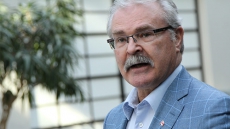WADENA, Sask. - CN Rail says the tanker cars that derailed and caught fire this week near a small community in Saskatchewan are the same type as those involved in the Lac Megantic disaster last year.
Jim Feeny says the Class DOT-111 rail cars are owned by shippers or leasing companies and CN has no choice but to accept them.
Almost three-quarters of the tanker cars used in North America are 111s.
Feeny says regulators on both sides of the border have laid out a time frame to replace the older cars, but it will take time.
"We are on record as favouring a very aggressive phase-out of the older model DOT-111s, but we are required to accept these cars at this point," Feeny told radio station CKRM Thursday.
"We are required to operate them. We have no choice in that matter. We are calling on the industry and the federal government to phase them out, but the fact is, there are many of them, and it will take time to do this."
Both CN and CP have said they are already phasing out or retrofitting their fleet.
Dozens of people had to leave their homes this week in Clair, Sask., and surrounding area when 26 cars derailed and two of them carrying petroleum distillate caught fire.
Forty-seven people were killed when a runaway train carrying crude oil barrelled down a hill, derailed and exploded in downtown Lac Megantic in July 2013.
The Association of American Railroads has recommended that the 111s used to transport flammable liquids be retrofitted or phased out and wants a reinforced standard for new tank cars.
The 111 car is considered the workhorse of the North American fleet and makes up about 70 per cent of all tankers on the rails. The cars have a service life of between 30 and 40 years.
Since October 2011, all new tanker cars have been built to safer specifications. But there is a long backlog on new car orders because there are only a handful of manufacturers in North America.
A government-commissioned report has said there are about 228,000 DOT-111 cars in service throughout North America. About 92,000 of them carry flammable liquids.
About 26,000 reinforced models have been put into service and that's expected to rise to 52,500 next year.
Adam Scott, a spokesman for the advocacy group Environmental Defence, said Canada has seen an exponential growth in the amount of oil travelling by rail.
"The rail system was not designed with public safety in mind for that much oil," said Scott, who added that the DOT-111 cars are generally used.
"They have well-documented safety problems," he said. "They are very thin and in crashes they do tend to leak and explode."
Scott said freight rail lines "actually go right through the centre of almost every major urban centre in the entire country including small towns ... so the risk of accidents is significant."





